5 Best Bedroom Colors for Autistic Kids. Painting a bedroom can be difficult for parents of autistic children.
They must not only manage the room’s safety and comfort, but they must also choose the appropriate colors.
Because of their soothing and calming effects, muted greens, powdered blues, pale pinks, pale violets, soft oranges, and neutrals – such as gray, beige, ivory, and earth tones – are the best bedroom colors for autistic children.
The worst bedroom colors for autistic children are bold colors with a high saturation like red, yellow, orange, vibrant blue, and even stark white because autistic children are likely to see these colors as being fluorescent and overwhelming – potentially causing anxiety and overstimulation.
The rest of this article will give you 5 specific color palettes to use in your autistic child’s bedroom, as well as 6 steps to creating a calming sensory bedroom.
Alternatively: if you’d like to find the most comfortable and suitable mattress for your autistic child to help with their sleep, then check out my list of the best mattresses for autistic children here.
What Bedroom Colors for Autistic Kids?
Soft and muted colors are generally recommended for individuals with autism. These colors create a calm and relaxed atmosphere that can help reduce sensory overload and anxiety. Shades of blue, green, and neutral tones like beige and soft gray are often considered favorable.
Why are soft and muted colors recommended?
Soft and muted colors have a gentle and understated presence that can promote a sense of tranquility. They are less visually stimulating and can help individuals with autism feel more at ease in their environment. Bright and bold colors can be overwhelming and may contribute to sensory sensitivities.
Are there specific colors to avoid?
It’s advisable to avoid highly saturated or intense colors, as well as contrasting color combinations. These can be visually jarring and potentially increase sensory challenges for individuals with autism. It’s best to prioritize colors that promote a sense of calm and balance.
Should individual preferences be considered?
Yes, individual preferences should be taken into account when choosing room colors for individuals with autism. While certain colors are generally recommended, it’s important to consider the specific preferences and sensitivities of the individual. Some people may have personal color preferences that make them feel more comfortable and engaged.
Are there any specific color combinations to consider?
Combining soft and muted colors in a harmonious way is key. Neutral colors like beige or soft gray can serve as a base, while subtle shades of blue and green can be added as accents. Monochromatic or analogous color schemes tend to be well-received by individuals with autism.
The Journal of Autism and Developmental Disorders published research on the prevalence of sensory impairments in ASD children [1].
Children on this spectrum can perceive colors more intensely than other children.
As a result, bright and bold colors should be avoided because they can overwhelm and disorient children with sensory issues.
Below are 5 of the best paint colors that you can use in bedrooms for children with ASD (you can copy the hex values (#) into the Adobe Color Wheel to create your own palettes):
1: Green – Soft and Soothing
Green is a color that represents nature and growth.
Green colors are soft and soothing, and they can evoke feelings of joy and serenity in children.
Light green hues can help with stress management by dissipating the signs of agitation and chaos that children with sensory issues experience.
Autism-friendly green color palette suggestions:

- 1: #898C6D
- 2: #4B4D3C
- 3: #C8CDA0
- 4: #D3D9A9
- 5: #AEB38B
2: Blue – Relaxing and Secure
Blue has also been suggested as a good color for children with autism.
The color is frequently described as neat, soothing, and secure.
Light blue hues contribute to the creation of a pleasing and serene environment, which helps to calm your sensory-sensitive child and encourage positive attitudes and interactions.
You can try this autism-friendly blue color palette:

- 1: #5B7A85
- 2: #304045
- 3: #88B5C4
- 4: #90C1D1
- 5: #769EAB
3: Pale Pink and Violet – Safety and Love
Pale pink or violet are soothing colors for your sensory-sensitive child, evoking feelings of safety and love.
They create the most pleasant atmosphere in the room, making it easier for autistic children to focus on the task at hand while also relaxing and sleeping when it is bedtime.
Here is an autism-friendly pink and violet palette that you can customize to your liking:

- 1: #FFDBCF
- 2: #FFD3CF
- 3: #FFDBE1
- 4: #FFCFEF
- 5: #FACFFF
4: Soft Orange – Warming Comfort
Orange is thought to be a cheerful and bright color.
However, by selecting the right tones, you can create a nice warm glow in the bedroom.
To create a warm and comforting environment for autistic children, use a pale and muted orange paint color.
As a result, children with ASD will feel safe and secure, with no distress.
Here are some soft orange colors to experiment with:

- 1: #F0D8A8
- 2: #F0D0A8
- 3: #EFCDB4
- 4: #F0BBA8
- 5: #F0B0A8
5: Neutrals – Non-Distracting and Calming
Non-distracting colors that help accommodate children with autism include gray, beige, ivory, and earth tones.
Muted colors soothe sensory-sensitive children and promote concentration and learning abilities.
Although white is a neutral color, because it is too bright, dull, and tiring on the eyes, it creates an unpleasant environment for your autistic child.
Here’s a calming neutral palette you can work with and modify as needed:

- 1: #D6CCB2
- 2: #E0D2BA
- 3: #C9BDB1
- 4: #E0C8BA
- 5: #D6B9B2
How to Create a Calming Sensory Bedroom
A sensory-sensitive child’s bedroom should never be a place of discomfort and isolation; instead, it should be warm, calm, and safe.
However, parents with autistic children may find it difficult to create a calming sensory bedroom environment.
Choose calming colors, dim the lighting, reduce noise, eliminate clutter, choose a sensory-friendly mattress and bedding, and finally remove electronic devices from the room when designing the best calming sensory bedroom for children with Autism.
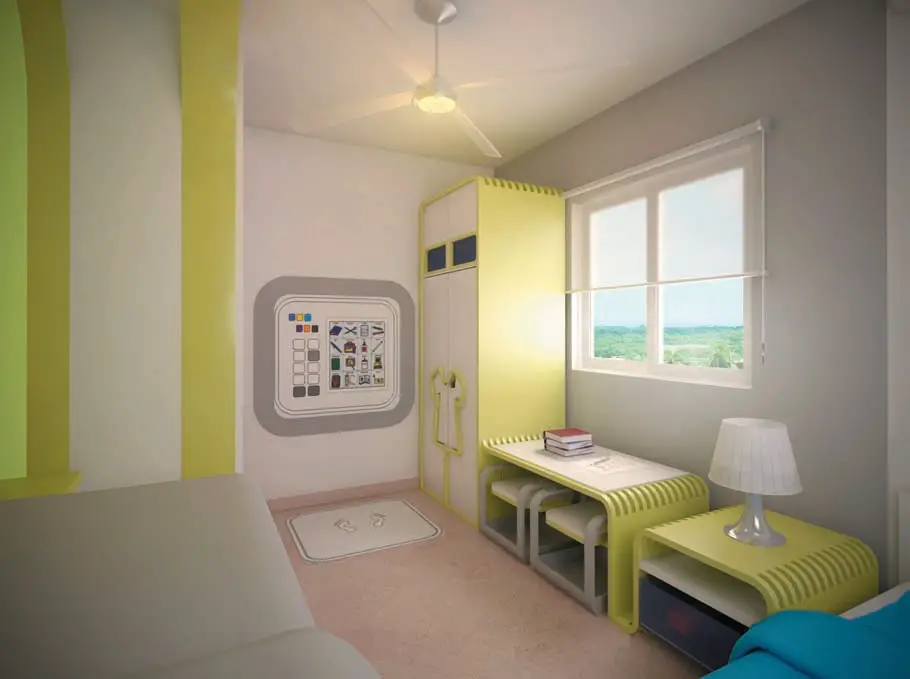
In six easy steps, you can create a soothing sensory bedroom:
1: Choose Calming Colors
Strong colors with a high saturation are distracting to autistic children because they are more sensitive to stimulation than typical children.
Colors that are overly stimulating, such as red, yellow, and stark white, can be extremely disturbing.
As a result, keep bright colors for lightweight toys and accessories that can be easily stored away out of sight when not in use.
Using calming colors, on the other hand, can typically create an ideal environment to help children with ASD decompress when they are feeling overwhelmed and agitated; they can calm their pulse rate, reduce their tension, and improve their concentration.
As a result, choose soothing colors that are pale, soft, and muted, such as pale pink, pastel green, light blues, lavender, peach, and neutrals.
If your child has a favorite color, choose a lighter version of that color to create a more comfortable and peaceful environment and avoid overstimulation.
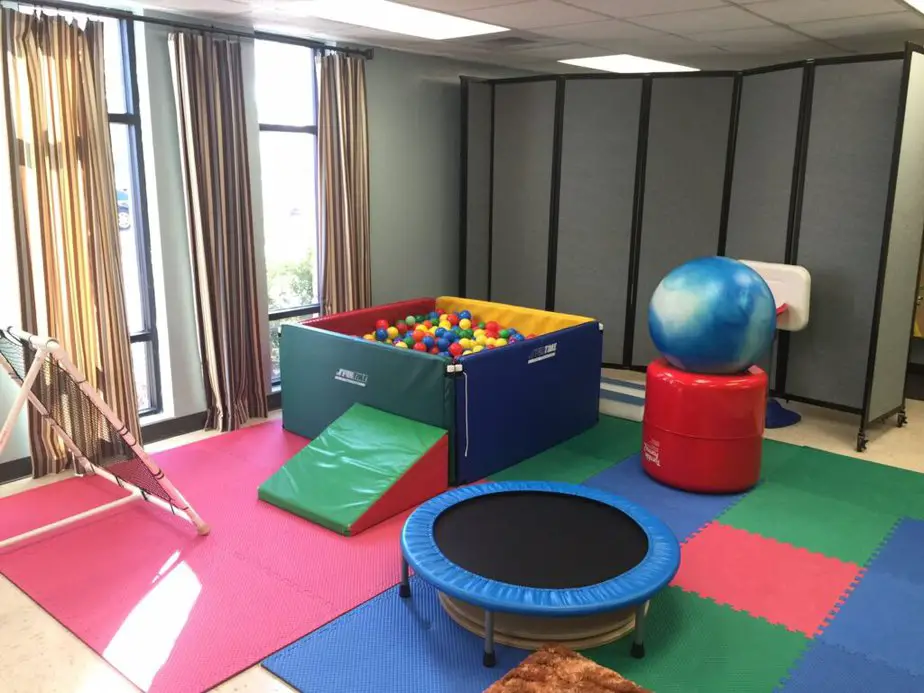
2: Soften the Lighting
Children with autism are also light-sensitive, with bright or fluorescent lights and excessive sunlight being perceived as disturbing.
Allow natural light into the bedroom for daytime activities; incandescent desk and floor lamps can be used when natural light is insufficient.
Consider getting blackout curtains to block out the sunlight during the day and the lights outside the windows from street lamps and cars at night.
Install a dimmer light to adjust the brightness of the light to your child’s needs for the evening.
Because of low levels of melatonin released at night, most sensory-sensitive children with autism have sleep disorders.
Add red nightlights to help promote sleep because they can increase melatonin levels and put the child in a state of tranquility and relaxation.
3: Reduce Noise
Children with autism can also be sensitive to sounds.
They are frequently seen covering their ears with their hands to block out the noise.
As a result, select soundproofing materials to make your child’s bedroom as sensory-friendly as possible.
When it comes to flooring, use a carpet or a rug to reduce ambient noises while cushioning our footsteps.
Carpets are more comfortable to walk on than hardwood and tiles because they are quieter, softer, and warmer.
If you don’t want to put a carpet in your space, choose vinyl planks over real wood for your floor because they absorb more sound.
Reduce noise on the walls by using materials such as wall hangings, heavy curtains, and large pieces of furniture placed against the wall.
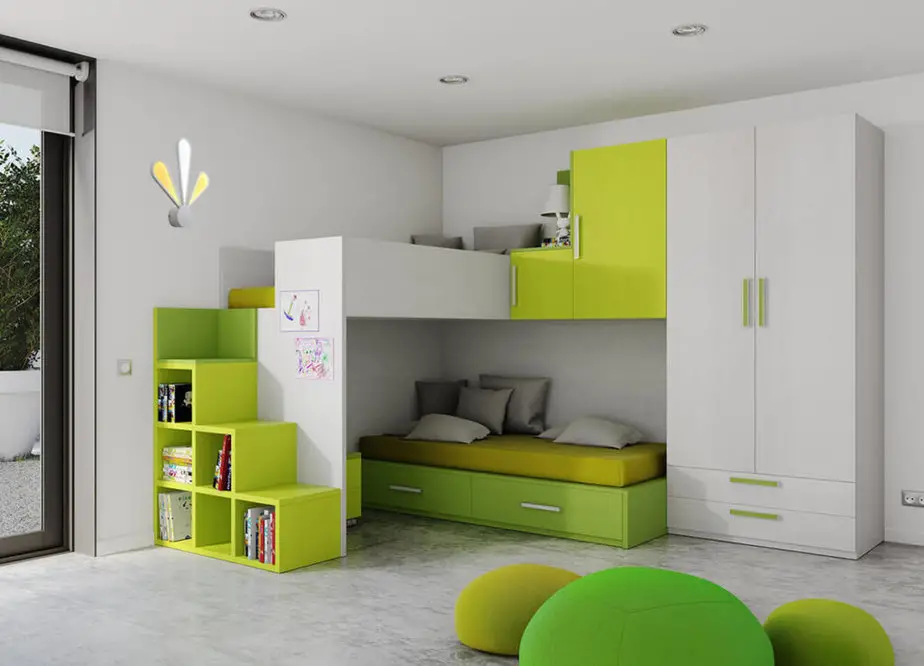
4: Create a Clutter-Free Space
Clutter and disarray can cause anxiety in autistic children.
In this case, the best you can do is clear away the visual clutter and keep your furniture selection to a minimum.
Use storage options like wall shelves and drawers to keep items within reach but out of sight.
Multipurpose furniture, such as a trundle bed or extra drawers underneath, should be included.
You can also add a few baskets and plastic storage containers to help clear the floor of clutter.
5: Remove Electronic Devices
Children with Autism Spectrum Disorder (ASD) may be more sensitive to electromagnetic fields emitted by electronic devices.
In fact, some studies suggest that spending too much time on screens and electronic devices like TV, phones, and computers can cause autistic-like symptoms, such as increased anxiety, disrupted sleep, and attention deficit.
Having said that, remove all electronic devices from the bedroom to avoid overstimulation, as using electronic devices can be hypnotically disturbing for sensory-sensitive children.
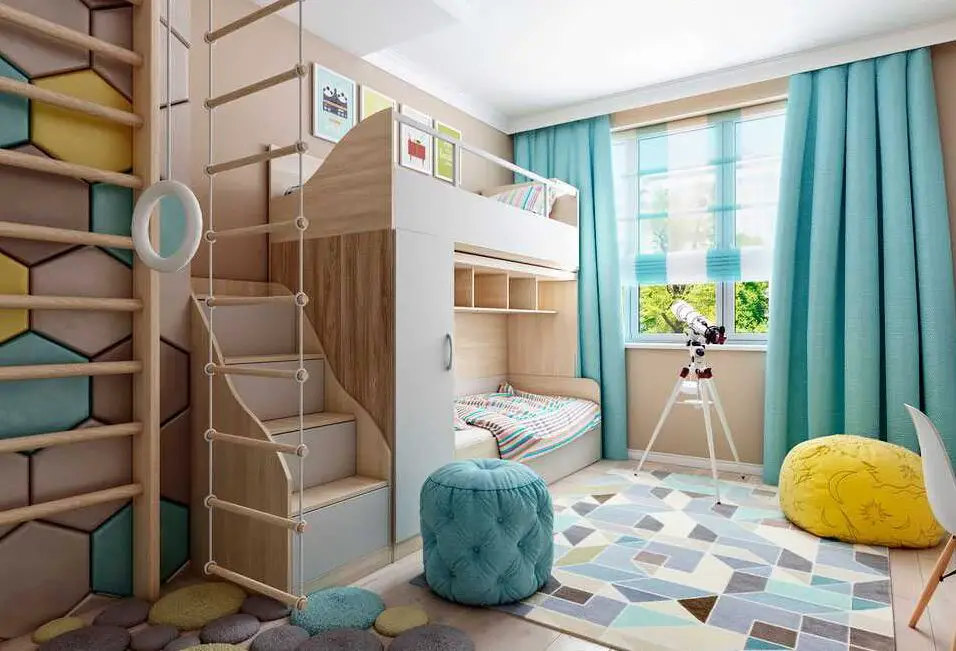
6: Select a Sensory-Friendly Mattress and Bedding
Children with ASD have poorer sleep quality than typically developing children.
They occasionally have trouble falling asleep and staying asleep throughout the night.
As a result, it’s critical to find the right bed frame, mattress, and bedding for your sensory-sensitive child.
To begin, if your child is a warm sleeper who sweats during the night, look for a bed with slats that are at least 1.5 inches apart.
The slats allow for proper airflow and keep heat from becoming trapped inside the mattress.
A breathable mattress made of latex or natural fibers is another option.
Avoid heat-insulating sheets like polyester and silk, and keep the bedroom temperature low to promote a cool sleeping environment for your child.
Second, if your child sleeps on his or her side, look for a memory foam mattress that will cushion the hip and shoulder pressure points while maintaining a neutral spine alignment (but NEVER allow a baby or infant to sleep on a memory foam mattress since this can potentially lead to suffocation and death [2]).
So, whatever you decide, make sure it meets your child’s needs and preferences.
Finally, if your child is tense at night and has difficulty relaxing and falling asleep, use a compression blanket or sheets.
The soft material of compression bed sheets cradles and holds your child in place, creating a sense of security and safety.
Let there be light!
Autistic individuals are often sensitive to light. It has been proven that they are more comfortable with natural lighting, and they can become more irritable and capricious in rooms with bright artificial lighting. It’s better to have a room with large windows. However, avoid daylight lamps as they flicker and can be uncomfortable for autistic individuals.
The calmest place!
It is highly recommended to create a sensory relief corner with no visual, tactile, or auditory irritants (something like a comfortable tent) where the child can hide and calm down.
Keep it simple!
When decorating rooms, try to avoid flashy curtains, colorful pictures on the walls, and furniture with complex designs. While experimenting with non-standard interiors may be acceptable for ordinary people and can even shock them, doing so with autistic individuals can cause anxiety and make them withdraw further into themselves.
Soothing colors!
An autistic person may have a favorite color, but it’s not advisable to use it too prominently in the interior. For example, if a child is drawn to orange objects, you can paint the walls of their room a light peach color and leave orange for a few select items (such as a pouf or a couple of cushions). An abundance of bright colors in the room is a taboo.
By the way, an excess of white in the interior is not suitable for many autistic individuals because it is associated with hospitals. Choose colors like ivory, beige, coffee, mint, or light gray. These colors fit various interior styles and do not provoke excessive visual irritation. On the contrary, they contribute to a calm emotional state and appropriate behavior.
Separate play from rest!
Avoid overdoing minimalism and turning your child’s home into an empty, bright box with only a few essential items. The key is to follow zoning rules. Play and learning areas must be a) clearly separated from areas where the child can rest, and b) specially designed to suit the autistic individual’s needs.
Related Questions
The following are the complete answers to some of the questions about painting your autism-friendly bedroom:
What is Autism Color Therapy and Does it Work?
Colors, in general, influence our mood and attitude.
Certain colors can stimulate the brain and elicit feelings of excitement or danger, whereas others can elicit feelings of tranquillity and peace of mind.
Color therapy is the use of specific colors and their wavelengths to treat physical and emotional ailments.
It can entail projecting a specific color onto a specific body part or looking at a specific color with the eyes.
Children with autism perceive colors more intensely than normal children due to some neural deficits and eye-structure anomalies.
In this case, color therapy is an excellent tool for helping you understand how your autistic child reacts to various colors.
Light and muted colors, such as soft green and pale pink, help them stay calm and focused, whereas bright colors, such as red and yellow, can cause tantrums.
Color therapy sessions produce different results for different people.
However, once you understand the effects of colors on your autistic child, you will be able to create a better environment for your child to relieve symptoms and mood disorders.
What Are the Worst Bedroom Colors for Autism?
Full-intensity colors like red, yellow, orange, and shiny blue create a very distracting environment for children with ASD and are regarded as the worst bedroom colors for children with autism.
Bright colors are perceived as fluorescent by sensory-sensitive children, which can have a negative impact on their mood and overall health; they raise blood pressure and pulse rate, causing anxiety and perturbation.
As a result, bright colors and patterns should not be used in bedrooms for autistic children or in pediatric medical clinics.
Stark white should also be avoided because it can appear cold, depressive, and tiring on the eyes, as well as reminding your autistic child of unpleasant doctor visits.
How Else Can You Make a Bedroom Autism-Friendly?
As stated in the article, autistic children perceive things more intensely than typical children.
The lights appear brighter, the sounds are louder, the smells are stronger, and the touch and taste are more intense.
Remember that comfort is essential when designing an autism-friendly bedroom.
So, in addition to choosing calming colors, here are a few other things to think about:
Daytime activities require autistic children to remain calm and focused on the task at hand.
Ensure that the bedroom is clutter-free and that all hazardous items are safely stored.
Also, allow plenty of natural light into the bedroom because children with ASD respond well to it.
Curtains, on the other hand, are a good option for blocking out the sun when it is too bright.
A sufficient amount of sunlight will improve your child’s energy levels and attention, but too much light will disturb and irritate them.
On the other hand, you must instill a sense of security and comfort within the room.
A sensory pea pod is an excellent piece of furniture that can be used as a cozy nest for your sensory child.
When the child is tense and overwhelmed, this piece of furniture helps him or her feel safe and rested.
Children with autism must be able to fall and stay asleep without any distractions at night.
Keep noise to a minimum to ensure maximum comfort.
To block out sounds such as air conditioning or car sounds, use a sound machine that produces white noise.
You can also play some meditative music to get your child ready for bed.
Purchase a mattress and bedding that are appropriate for your sensory child’s needs.
A weighted blanket or sleeping bag can help your autistic child relax and unwind.
Sensory toys are also self-soothing items that children hold and squeeze for comfort.
Additionally, install a dimmer light to adjust the intensity of the lights inside the room, as well as curtains to block out the lights from street lamps and cars, to create a visually soft environment.
What colors do autistic individuals prefer?
Subdued colors have a calming effect on children with autism. Tests conducted by foreign researchers have shown that pale pink (Figure 1) is one of the most beloved colors among autistic children, but the first place on the list.
What color do autistic individuals choose?
Children with autism tend to avoid the color yellow, preferring shades of green.
Conclusion: Focus on the Overall Ambience
Choosing the right colors for your autistic child’s bedroom, such as greens, blues, pale pinks, soft oranges, and earthy neutrals, is the first step.
The following step is to consider the overall ambiance of the room, which includes softening the lighting, reducing noise, removing clutter, and removing electronic devices.
It is also critical to select the best sensory-friendly mattress.
To see the best mattresses to buy for your autistic child right now, click the button below.

I joined Appartenville in February 2021 as a content editor. After studying English literature at university, I worked as an e-commerce website editor, content author, and purchasing intern for several independent luxury and lifestyle retail companies. My role at Appartenville combines my love, experience, and passion for the world of design and the desire to create inspiring written content. As for my personal style, I am a big fan of color and drawing, especially I like the pastel color scheme. I also enjoy discovering new trends, brands, and products, whether it’s fashion, interior design, or lifestyle my wish list for buying new things is endless.
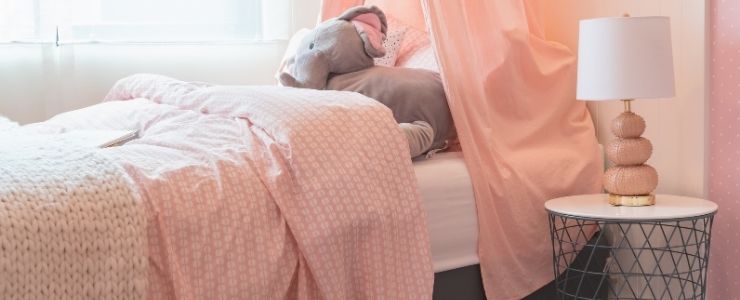
Leave a Reply